
Marianne Halbert, the criminal justice director at NAMI Indiana, said knowing what resources are available can divert people away from jails and prisons — which is where Sequential Intercept Model, or SIM, mapping comes in.
PixabaySome counties are looking for new ways to improve interactions between law enforcement and people experiencing a mental health crisis. The National Alliance on Mental Illness is coordinating with local advisory councils to provide crisis intervention training and resource mapping.
Chris Biehn is the deputy director of the Justice Services Division at Indiana Office of Court Services, which works with Local Justice Reinvestment Advisory Councils. These councils are tasked with reviewing criminal justice practices and making recommendations to the state JRAC.
He said local JRACs are interested in crisis intervention training and resource mapping to determine what options the legal system has to help people having a mental health crisis.
“What do those things look like?” Biehn said. “And when you make this decision, judge, what does that do for treatment? What does that do for probation? What does that do for your pretrial services? How do we tie people into the problem solving court a little bit earlier?”
Biehn said creating more crisis intervention teams and mapping community resources breaks down silos in the process.
Marianne Halbert, the criminal justice director at NAMI Indiana, said knowing what resources are available can divert people away from jails and prisons — which is where Sequential Intercept Model, or SIM, mapping comes in.
“That's where you're bringing stakeholders together to really diagram how people with mental illness come into contact with and move through your criminal justice system and crisis response system,” Halbert said.
Join the conversation and sign up for the Indiana Two-Way. Text "Indiana" to 73224. Your comments and questions in response to our weekly text help us find the answers you need on statewide issues, including our project Civically, Indiana.
The SIM model is an evidence-based approach that identifies different points, or intercepts, where the system can identify and support someone with a mental illness. For “Intercept 1,” which refers to law enforcement, this could mean more training for officers or using emergency rooms to “triage” a mental health crisis.
The model has six intercepts in total, including community resources, law enforcement, initial detention and court hearings, jails and courts, reentry, and community corrections. Community resources are considered “Intercept 0.”
“That is the one that would envision a situation where we had such a robust community mental health system and crisis response system pre-911 call that people would never have to call 911 regarding a mental health crisis,” Halbert said.
While the model was developed by Policy Research Associates, NAMI Indiana also offers technical assistance.
“We produce a physical map of your system and we generate a report that includes a strategic plan and the community members who participate in the mapping workshop, you'll choose your priorities,” Halbert said.
Halbert said SIM mapping is used across the country to improve crisis response systems. She said that if the Department of Justice has to step in following an incident, it will often “force communities to implement” the model.
“We certainly want to get ahead of that, not wait for something tragic to happen or communities to be forced to do that,” Halbert said. “We feel like the carrot is a better approach than the stick.”
Halbert said NAMI Indiana acts as a “neutral” facilitating party as communities identify their priorities for the next few years. After about three to five years, the organization will remap their system to identify improvements or additional areas of concern.
Abigail is our health reporter. Contact them at aruhman@wboi.org.
9(MDAyMzk1MzA4MDE2MjY3OTY1MjM5ZDJjYQ000))
 DONATE
DONATE






 Support WFYI. We can't do it without you.
Support WFYI. We can't do it without you.